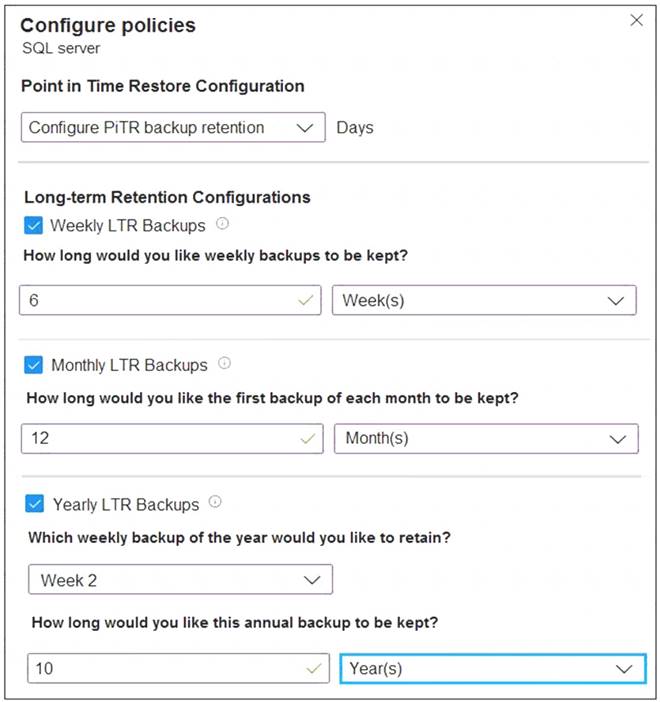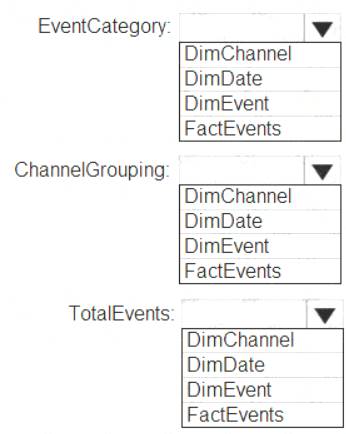- (Exam Topic 5)
You configure a long-term retention policy for an Azure SQL database as shown in the exhibit. (Click the
Exhibit tab.)
The first weekly backup occurred on January 4, 2020. The dates for the first 10 weekly backups are: January 4, 2020
January 4, 2020 January 11, 2020
January 11, 2020 January 18, 2020
January 18, 2020 January 25, 2020
January 25, 2020 February 1, 2020
February 1, 2020 February 8, 2020
February 8, 2020 February 15, 2020
February 15, 2020 February 22, 2020
February 22, 2020 February 29, 2020
February 29, 2020 March 7, 2020
March 7, 2020
Use the drop-down menus to select the answer choice that completes each statement based on the information presented in the graphic.
NOTE:Each correct selection is worth one point.
Solution:
Graphical user interface, text, application, email Description automatically generated
Does this meet the goal?
Correct Answer:
A
- (Exam Topic 5)
You are planning a solution that will use Azure SQL Database. Usage of the solution will peak from October 1 to January 1 each year.
During peak usage, the database will require the following:  24 cores
24 cores 500 GB of storage
500 GB of storage  124 GB of memory
124 GB of memory More than 50,000 IOPS
More than 50,000 IOPS
During periods of off-peak usage, the service tier of Azure SQL Database will be set to Standard. Which service tier should you use during peak usage?
Correct Answer:
A
Reference:
https://docs.microsoft.com/en-us/azure/azure-sql/database/resource-limits-vcore-single-databases#business-critic
- (Exam Topic 5)
You have an Azure SQL Database server named sqlsrv1 that hosts 10 Azure SQL databases. The databases perform slower than expected.
You need to identify whether the performance issue relates to the use of tempdb on sqlsrv1. What should you do?
Correct Answer:
D
The diagnostics log outputs tempDB contention details. You can use the information as the starting point for troubleshooting.
You can use the Intelligent Insights performance diagnostics log of Azure SQL Database to troubleshoot performance issues.
Reference:
https://docs.microsoft.com/en-us/azure/azure-sql/database/intelligent-insights-troubleshoot-performance#tempdb https://docs.microsoft.com/en-us/azure/azure-sql/database/intelligent-insights-use-diagnostics-log
- (Exam Topic 5)
From a website analytics system, you receive data extracts about user interactions such as downloads, link clicks, form submissions, and video plays.
The data contains the following columns:
You need to design a star schema to support analytical queries of the data. The star schema will contain four tables including a date dimension.
To which table should you add each column? To answer, select the appropriate options in the answer area.
NOTE:Each correct selection is worth one point.
Solution:
Graphical user interface, application, table Description automatically generated
Box 1: FactEvents
Fact tables store observations or events, and can be sales orders, stock balances, exchange rates, temperatures, etc.
Box 2: DimChannel
Dimension tables describe business entities – the things you model. Entities can include products, people, places, and concepts including time itself. The most consistent table you'll find in a star schema is a date dimension table. A dimension table contains a key column (or columns) that acts as a unique identifier, and descriptive columns.
Box 3: DimEvent Reference:
https://docs.microsoft.com/en-us/power-bi/guidance/star-schema
Does this meet the goal?
Correct Answer:
A
- (Exam Topic 5)
You are developing an application that uses Azure Data Lake Storage Gen 2.
You need to recommend a solution to grant permissions to a specific application for a limited time period. What should you include in the recommendation?
Correct Answer:
C
A shared access signature (SAS) provides secure delegated access to resources in your storage account. With a SAS, you have granular control over how a client can access your data. For example:
What resources the client may access.
What permissions they have to those resources. How long the SAS is valid.
Note: Data Lake Storage Gen2 supports the following authorization mechanisms:  Shared Key authorization
Shared Key authorization Shared access signature (SAS) authorization
Shared access signature (SAS) authorization Role-based access control (Azure RBAC)
Role-based access control (Azure RBAC) Shared Key authorization
Shared Key authorization Shared access signature (SAS) authorization
Shared access signature (SAS) authorization  Role-based access control (Azure RBAC)
Role-based access control (Azure RBAC) Access control lists (ACL)
Access control lists (ACL)
Reference:
https://docs.microsoft.com/en-us/azure/storage/common/storage-sas-overview

